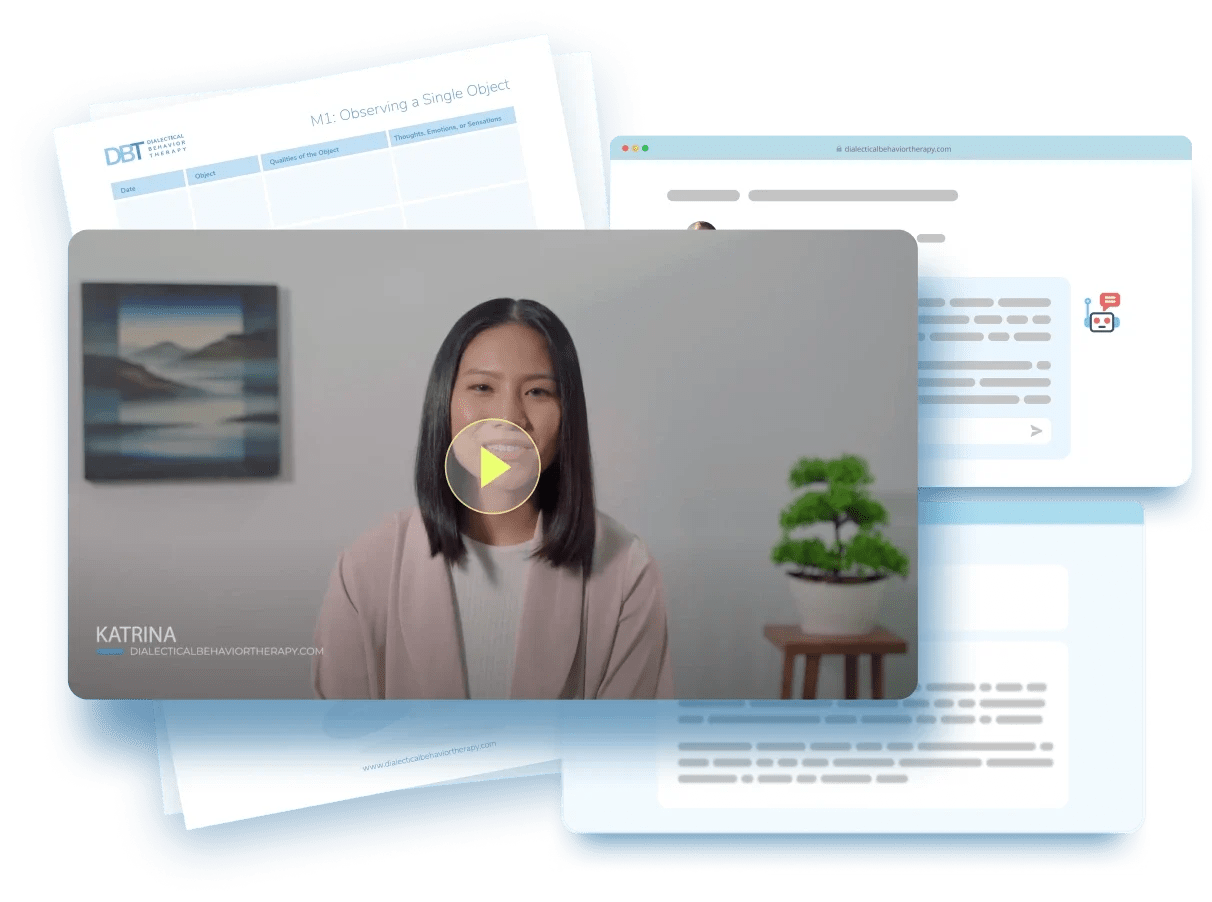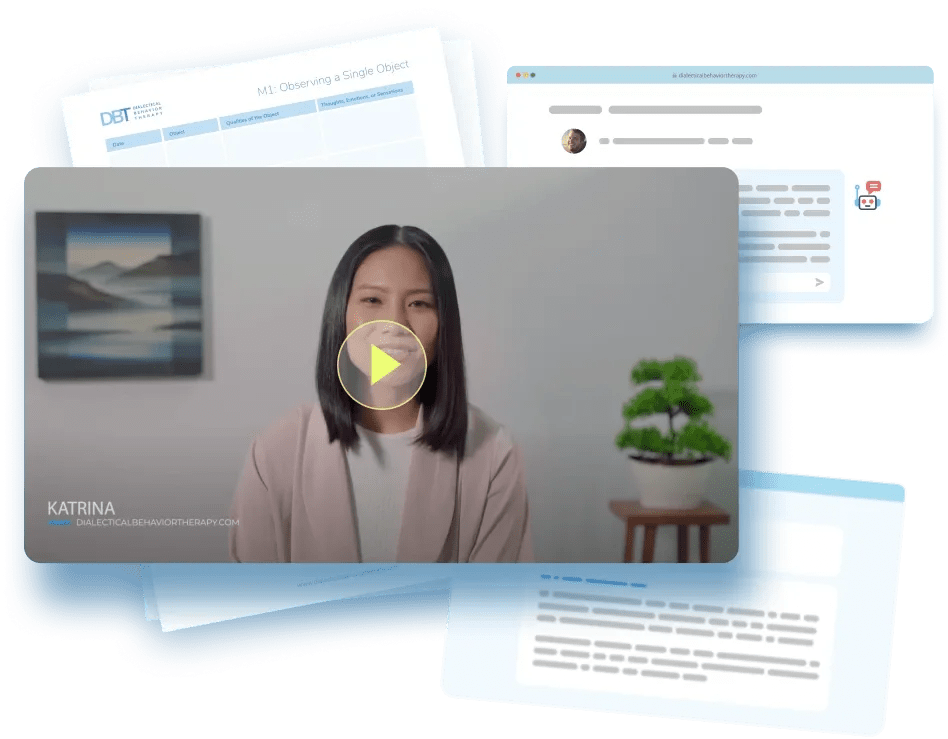What is Behavioral Activation & Exposure
When we feel anxious, low, or overwhelmed, it's easy to withdraw. We cancel plans, avoid responsibilities, or numb out with distractions. In the moment, this avoidance brings relief. But over time, it reinforces the very emotions we're trying to escape.
This cycle of avoidance can shrink your world and increase symptoms of anxiety, depression, and fear. The less you do, the worse you feel. And the worse you feel, the harder it becomes to re-engage with life.
That’s where behavioral activation and exposure come in.
These CBT-based skills help you take action even when motivation is low or fear is high. Behavioral activation focuses on reintroducing meaningful, mood-lifting activities. Exposure helps you gradually face what you fear, until avoidance no longer controls your life. Action is the antidote to avoidance, and every small step builds momentum toward change.
Behavioral Activation & Exposure as a CBT Module
Cognitive Behavioral Therapy includes four core modules, with behavioral activation and exposure serving as the action-based component. These strategies help individuals face avoidance, re-engage with meaningful activities, and reduce emotional avoidance patterns that reinforce anxiety and depression.
Once self-monitoring and awareness are in place, behavioral activation and exposure give clients the tools to take intentional steps forward, building confidence, disrupting avoidance cycles, and creating real-life opportunities for change.
What Behavioral Activation & Exposure Skills are taught in CBT?
The Behavioral Activation & Exposure Skills taught in CBT are "Activation" Skills and "Exposure & Coping" Skills
- 1
Activation Skills: These focus on increasing positive behaviors and building momentum through structure, mastery, and motivation.
- exercise BA1: Activity Schedule Pencil in one mastery and one pleasure activity per day. Even small actions, like tidying your space or calling a friend, can shift your emotional state when done consistently.
- exercise BA2: 5-Minute Starter Overwhelmed? Just commit to five minutes. This technique lowers the mental barrier to starting, making it easier to follow through.
- exercise BA3: Mastery-Pleasure Ratings Rate each activity for mastery (sense of accomplishment) and pleasure (enjoyment) on a 0–10 scale. Over time, you’ll spot which habits truly help your mood.
- exercise BA4: Graded Task List Break down large, stressful tasks into bite-sized pieces. Check them off as you go to build momentum and reduce overwhelm.
- exercise BA8: Successive Approximation Take a bigger goal and break it into micro-steps. Celebrate each step with a mini-reward to reinforce follow-through.
- exercise BA9: Reward Plan Break down large, stressful tasks into bite-sized pieces. Check them off as you go to build momentum and reduce overwhelm.
- 2
Exposure & Coping Skills:These help you face feared situations, reduce avoidance, and mentally prepare for distressing moments.
- exercise BA5: Exposure Hierarchy List feared tasks or situations in order from least to most distressing (using SUDS ratings). Start at the bottom and work your way up, one step at a time.
- exercise BA6: Imaginal Preview Mentally rehearse yourself succeeding at the first step of your exposure hierarchy. Visualization reduces anticipatory anxiety and strengthens readiness.
- exercise BA7: Opposite Action Day Notice an avoidance urge, then do the opposite. Feeling like isolating? Try texting a friend. This skill helps you disrupt emotional habits in real time.
- exercise BA10: Coping Ahead Script Pick a known trigger coming up tomorrow and mentally walk through it. Write out what you’ll think, feel, and do so you’re prepared to face it skillfully.
How Do Behavioral Activation & Exposure Techniques Help?
Behavioral activation and exposure are action-based CBT strategies that help you re-engage with life when avoidance, fear, or low motivation take over. These skills focus on doing. Like facing a fear, starting a neglected task, or scheduling simple, mood-lifting activities.
By taking small, intentional steps, you begin to reverse the cycle of avoidance that reinforces anxiety, depression, and emotional distress. These techniques don’t rely on feeling motivated first. They help create motivation through action.
Benefits of Behavioral Activation & Exposure
Even if you're not in therapy, using behavioral strategies in everyday life can help you break through inertia, reduce anxiety, and rebuild a sense of meaning and momentum. Here are some key benefits:
- Increased Motivation. Starting with small, manageable actions helps you regain energy and confidence, even when you don’t feel like it.
- Improved Mood. Regular engagement in meaningful or enjoyable activities can lift mood naturally over time, especially in cases of depression or burnout.
- Stronger Sense of Accomplishment. Breaking tasks into smaller steps and checking them off gives you a clear sense of progress and productivity.
- Greater Confidence. Facing challenges, even in small doses, builds self-efficacy, the belief that you can handle what comes your way.
- Better Daily Structure. Having a basic activity plan helps you stay grounded and less overwhelmed, especially during periods of stress or uncertainty.
- More Balanced Lifestyle. Behavioral activation encourages a healthier mix of work, play, rest, and connection, restoring a sense of balance and purpose.
How to Practice Behavioral Activation & Exposure in Real-Life
CBT encourages using action to shift emotion. Behavioral activation and exposure are about making small, intentional choices to re-engage with life, even when you feel stuck, anxious, or unmotivated. Here are practical ways to apply these skills in daily life.
Start with one small task. Pick something you’ve been avoiding and commit to just five minutes. Whether it’s replying to an email, folding laundry, or walking outside, getting started often unlocks momentum and reduces emotional resistance.
Schedule meaningful activities ahead of time. Don’t wait until you feel like doing something. Plan one small mastery activity (like organizing a drawer) and one pleasure activity (like watching a favorite show) each day to support emotional balance.
Face a fear in bite-sized steps. Choose something you’ve been avoiding, like driving, making a phone call, or starting a project, and break it down into a gradual exposure ladder. Start with the least distressing step and move up as your confidence builds.
Track how activities affect your mood. After completing an activity, rate your mood, sense of accomplishment, or enjoyment. Over time, you’ll see which tasks help lift your energy, and you’ll build trust in your ability to take action even on hard days.
Subscribe.
Get the DBT course. Free!
Get your full access to our 26-week DBT course.
Lessons emailed to you twice a week.

Frequently Asked Questions
Behavioral activation is a strategy that helps you take intentional action to improve your mood. Instead of waiting to feel motivated, you start with small, meaningful tasks that create structure, boost energy, and reduce avoidance. Especially helpful for depression and burnout.
Exposure helps you gradually face situations that trigger anxiety or avoidance. By approaching these situations instead of avoiding them, your brain learns that the fear is manageable. Over time, the emotional intensity decreases, and your confidence grows.
Nope! And that’s the point! Behavioral activation works even when motivation is low. Starting with just five minutes of a task can help spark momentum. Action often leads to motivation, not the other way around.
Yes. Avoidance can drain your mood and increase anxiety. Behavioral activation helps reverse that cycle by reintroducing structure and purpose. Exposure adds a layer of resilience by helping you face fears and regain a sense of control.
References
- Martell, C. R., Dimidjian, S., & Herman-Dunn, R. “Behavioral Activation for Depression: A Clinician’s Guide.” The Guilford Press. (2010).
- Jacobson, N. S., Martell, C. R., & Dimidjian, S. “Behavioral activation treatment for depression: Returning to contextual roots.” Clinical Psychology: Science and Practice, 8(3), 255–270. (2001).
- Mazzucchelli, T. G., Kane, R. T., & Rees, C. S. “Behavioral activation treatments for depression in adults: A meta-analysis and review.” Clinical Psychology: Science and Practice, 16(4), 383–411. (2009).
- Hembree, E. A., Rauch, S. A., & Foa, E. B. “Beyond the manual: The insider’s guide to prolonged exposure therapy for PTSD.” In V. M. Follette & J. I. Ruzek (Eds.), Cognitive-Behavioral Therapies for Trauma (2nd ed.), The Guilford Press. (2006).
- Hopko, D. R., Lejuez, C. W., Ruggiero, K. J., & Eifert, G. H. “Contemporary behavioral activation treatments for depression: Procedures, principles, and progress.” Clinical Psychology Review, 23(5), 699–717. (2003).



